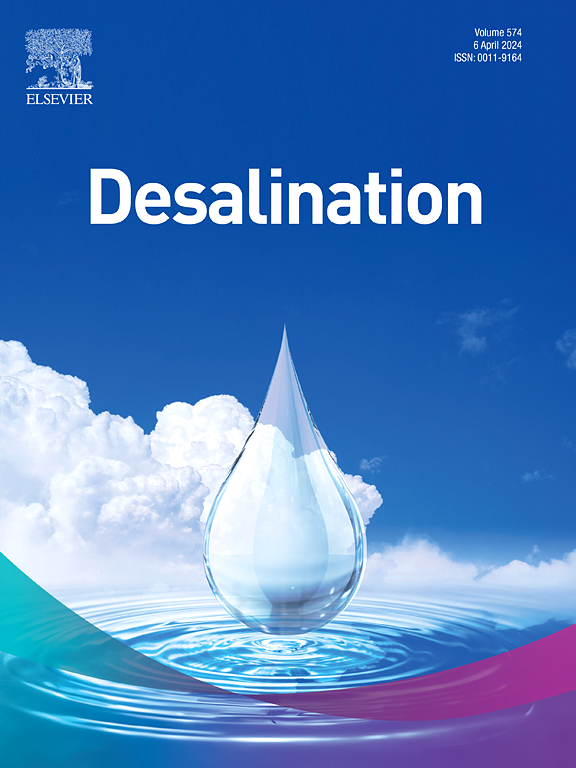Energy-efficient calcination-free mg cement recovered from desalination brine
IF 8.3
1区 工程技术
Q1 ENGINEERING, CHEMICAL
引用次数: 0
Abstract
Conventional ordinary Portland cement (PC) or magnesium-based cements' production typically involves energy-intensive calcination. In this work, the recovery of calcination-free Mg(OH)2-based low carbon cements from reject brine was demonstrated, addressing the global challenge of carbon neutrality. The use of electrochemical approach can reduce energy intensity by 52–78 % compared to PC, lowering it to 0.87–1.93 MWh per ton of Mg(OH)2, while eliminating 0.56 MWh (2.0 GJ) per ton of MgO required for calcination, targeting net carbon emissions of −0.31-0.41 ton CO2/ton. To enhance production efficiency and quality, the nanostructure of Mg(OH)2 was tailored using urea as a nano modifier and cross-linker in the harvesting process. At an optimum modifier dosage, Mg(OH)2 particles aligned with high surface exposure, thus presenting greater reactivity, pore volume and specific surface area. Thermogravimetric (TG), X-ray diffraction (XRD) and scanning electron microscopy (SEM) analyses performed on Mg(OH)2 revealed the optimum modifier content. The use of this Mg(OH)2 as a binder in carbonated samples revealed dypingite and nesquehonite as the main reaction products. The performance of Mg(OH)2 as a binder was influenced by its properties, which were dependent on the urea dosage. A critical modifier dosage of 0.2 mol/L yielded brucite with the highest SSA and reactivity, translating to the highest strength among all samples. The underlying mechanism could be attributed to the interlocking and synergistic effects arising from the optimal co-existence of rosette-like dypingite and rod-like nesquehonite.
从海水淡化卤水中回收节能免烧镁水泥
传统的普通硅酸盐水泥(PC)或镁基水泥的生产通常涉及能源密集型的煅烧。在这项工作中,展示了从废盐水中回收无煅烧Mg(OH)2基低碳水泥,解决了全球碳中和的挑战。与PC相比,使用电化学方法可以将能量强度降低52 - 78%,将其降至每吨Mg(OH)2 0.87-1.93 MWh,同时减少每吨MgO煅烧所需的0.56 MWh (2.0 GJ),目标净碳排放量为- 0.31-0.41吨CO2/吨。为了提高生产效率和质量,在收获过程中采用尿素作为纳米改性剂和交联剂,对Mg(OH)2的纳米结构进行了定制。在最佳改性剂用量下,Mg(OH)2颗粒呈高表面暴露排列,从而具有更大的反应性、孔体积和比表面积。通过热重(TG)、x射线衍射(XRD)和扫描电镜(SEM)分析,确定了Mg(OH)2的最佳改性剂含量。用这种Mg(OH)2作为碳酸盐样品的粘结剂,发现其主要反应产物是斑云石和嵌石。Mg(OH)2作为粘结剂的性能受其性能的影响,其性能与尿素用量有关。当改性剂用量为0.2 mol/L时,水镁石的SSA和反应活性最高,强度最高。其潜在机制可能是由于玫瑰花状斑云石和棒状斑云石的最佳共存所产生的连锁和协同效应。
本文章由计算机程序翻译,如有差异,请以英文原文为准。
求助全文
约1分钟内获得全文
求助全文
来源期刊

Desalination
工程技术-工程:化工
CiteScore
14.60
自引率
20.20%
发文量
619
审稿时长
41 days
期刊介绍:
Desalination is a scholarly journal that focuses on the field of desalination materials, processes, and associated technologies. It encompasses a wide range of disciplines and aims to publish exceptional papers in this area.
The journal invites submissions that explicitly revolve around water desalting and its applications to various sources such as seawater, groundwater, and wastewater. It particularly encourages research on diverse desalination methods including thermal, membrane, sorption, and hybrid processes.
By providing a platform for innovative studies, Desalination aims to advance the understanding and development of desalination technologies, promoting sustainable solutions for water scarcity challenges.
 求助内容:
求助内容: 应助结果提醒方式:
应助结果提醒方式:


